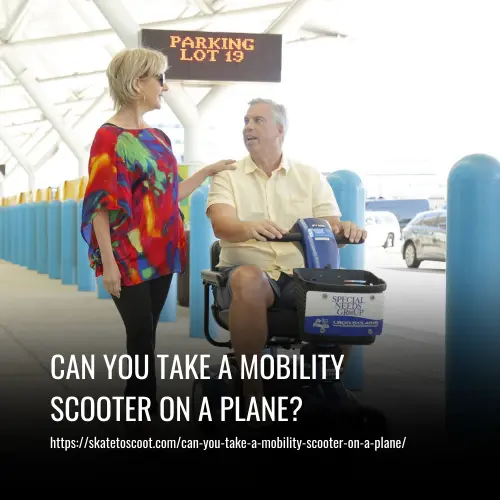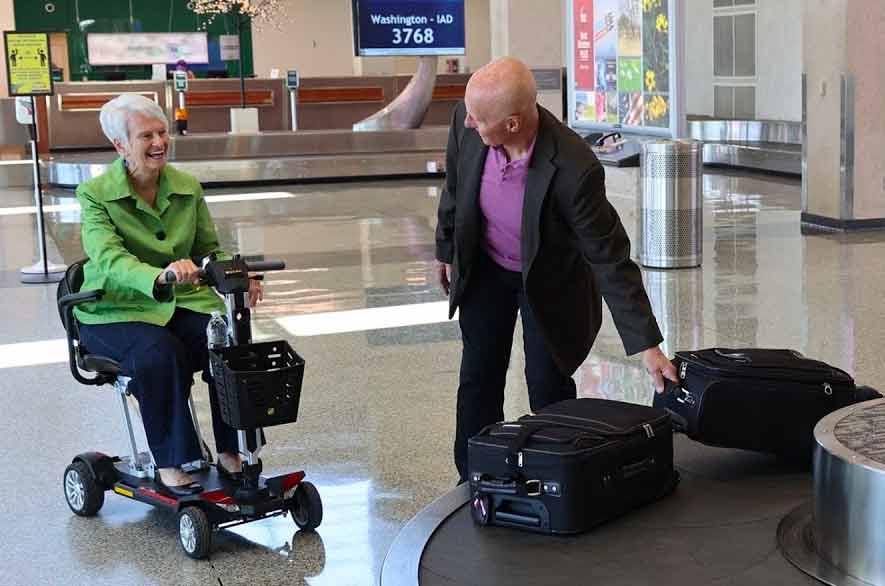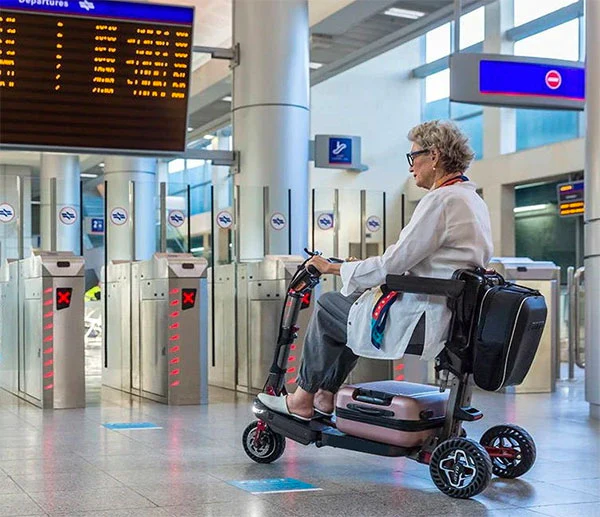Can You Take a Mobility Scooter on a Plane?
As an Amazon Associate we earn from qualifying purchases.
Yes, you can take a mobility scooter on a plane as long as its batteries comply with FAA guidelines. Lithium-ion batteries, which are commonly used in mobility scooters, are allowed as long as they have a rating of 100-watt hours or less. Passengers may also carry up to two spare larger lithium-ion batteries (101-160 Wh) with airline approval.
The batteries should be stored in a sealed container and should not be connected to the scooter during the flight. It’s important to check with your airline beforehand and provide proper documentation to ensure a smooth travel experience.

How to Prepare For Traveling on a Plane With a Mobility Scooter
When preparing to travel on a plane with a mobility scooter, it’s important to research airlines to find one that suits your needs. Contact the airline at least 48 hours before your flight to let them know you will be traveling with a mobility scooter. Many airlines transport medical devices, including mobility scooters, free of charge, but policies may vary. Share your scooter’s information with the customer service team and inquire about any necessary forms.
Arrive at least three hours before your scheduled departure and ensure your scooter is fully charged. Keep a spare key, battery charger, and plug adapter with you. Upon arrival at the airport, follow the airline’s instructions for checking in your device or using it to get to the gate.
It is advisable to take pictures of your scooter before handing it over to a worker and immediately upon its return to you to document any damages. During the check-in process, a customer service clerk will explain how your mobility scooter will be handled. For international flights, be sure to understand any special procedures for returning to the U.S.
Federal Rules For Traveling With A Mobility Scooter
When it comes to traveling with a mobility scooter on a plane, there are certain rules and regulations that must be followed to ensure safety for everyone involved. These rules are implemented by all airlines and it is important to be aware of them before your trip.
1. Checking Your Scooter
In most cases, you will need to check your scooter with baggage handlers so that it can be stored in the cargo hold. However, if your scooter is collapsible and uses lithium-ion batteries, such as the Go Go Folding Scooter 4-Wheel or the iRide, you may be able to bring it onboard.
2. Transporting Batteries
Most battery types are allowed aboard the plane, as long as they meet safety requirements. You can bring one spare battery with you, but it must be placed in your carry-on luggage. For lithium-ion batteries, you can bring up to two as long as each battery does not exceed 160 watt hours.
3. Battery Safety
During the boarding process, the airline crew will inspect your batteries and electrical connections to ensure they are safe for transport. If your batteries pass the safety checks, you will not be required to disconnect them. It is also important for your scooter to have a safeguard against accidental activation, such as a key or an on/off switch.
It is important for travelers with mobility scooters to familiarize themselves with the federal rules and regulations regarding their transportation on airplanes. By following these guidelines, you can ensure a smooth and hassle-free travel experience.

Understanding Airline Policies for Mobility Scooters
When it comes to traveling by air with a mobility scooter, it is essential to understand and adhere to the airline’s policies and guidelines. While each airline may have its own specific rules, there are some general principles to keep in mind.
1. Advance Notification
Most airlines require passengers to inform them in advance if they will be traveling with a mobility scooter. This allows the airline staff to make necessary preparations for storage and ensure there is sufficient space available.
2. Battery Type Matters
The type of battery your mobility scooter uses can significantly impact its eligibility for air travel. Many airlines allow scooters with dry or gel cell batteries, but there may be restrictions or additional precautions for scooters with wet or spillable batteries. It is essential to check with the airline regarding their specific requirements.
3. Collapsible vs. Non-Collapsible
Some airlines prefer or even mandate that mobility scooters be collapsible for storage in the aircraft hold. This requirement may vary depending on the size of the plane and the available storage space. It is advisable to contact the airline in advance to confirm whether your scooter needs to be collapsible.
4. Domestic Flights vs. International Flights
Legal rules regarding the transportation of mobility aids, such as mobility scooters, can vary from country to country. When traveling domestically within the U.S., it is essential to follow the guidelines provided by your airline and inform their customer service team if any special procedures need to be followed.
However, if you are traveling internationally, it is recommended to speak to your airline’s customer service team for specific instructions and requirements when traveling back to the U.S. This will ensure that you have the necessary documentation and comply with any regulations regarding the transportation of mobility aids.
Understanding airline policies for traveling with a mobility scooter is crucial to ensure a smooth and hassle-free journey.
Pre-Flight Preparations for Your Mobility Scooter
To ensure a hassle-free experience when traveling with your mobility scooter, it’s important to be proactive and prepared. Here are some pre-flight preparations to consider:
1. Check the Airline’s Website
Before booking your flight, it’s advisable to visit the airline’s website and familiarize yourself with their specific policies regarding mobility scooters. Most airlines provide detailed information on their website, including any restrictions or requirements for traveling with mobility devices.
2. Battery Preparations
If your mobility scooter uses a lithium battery, there are certain precautions you should take. Firstly, ensure that the battery is correctly labeled with watt-hour information, as this may be required by the airline. It’s also a good idea to fully charge the battery before your flight, although some airlines may require you to disconnect it during transit.
3. Documentation
Depending on the airline, you may be asked to provide documentation or a declaration regarding the battery type of your mobility scooter and its compliance with safety standards. It’s important to have this documentation ready to ensure a smooth check-in process.
By taking these pre-flight preparations and planning ahead, you can set yourself up for a stress-free journey with your mobility scooter.
At the Airport: Navigating the Process
Traveling with a mobility scooter requires some additional steps to ensure a smooth journey. Here’s what you need to know when arriving at the airport:
1. Early Arrival
To avoid any last-minute rush or delays, it is recommended to arrive at the airport at least 2-3 hours before your scheduled flight. This will give you ample time for check-in, security checks, and any necessary arrangements for your mobility scooter.
2. Check-in
When you reach the check-in counter, declare that you are traveling with a mobility scooter. The airline staff will provide you with the necessary information and guide you on the next steps. This may include dismantling certain parts of the scooter or securing the battery. Make sure to follow their instructions carefully.
3. Security
Mobility scooters, like other electronic devices, are subject to security screening. Follow the guidelines provided by the airport security personnel. Be prepared to have your mobility scooter undergo additional inspection as part of the security process.
4. Boarding
Passengers with mobility aids, including mobility scooters, are typically boarded before other passengers. This allows the ground staff to properly store the scooter in the aircraft, ensuring it is safely secured during the flight.
Arriving at Your Destination: Retrieving Your Mobility Scooter
Upon arriving at your destination, there are a few important steps to follow in order to retrieve your mobility scooter.
1. Wait for Assistance
If you have used an airline wheelchair to disembark from the plane, it is best to wait for assistance to retrieve your mobility scooter. Depending on the airport, your scooter may be brought to the aircraft door or the baggage claim area. This ensures a smooth transition and eliminates any potential confusion or inconvenience.
2. Check for Damages
Once you have your mobility scooter, it is essential to inspect it for any damages that may have occurred during transit. Take the time to thoroughly examine the scooter for any scratches, dents, or mechanical issues. If you notice any problems, it is important to report them immediately to the airline’s customer service. This will allow you to file a damage claim and address the issue promptly.
3. Reassemble if Needed
If any parts of your mobility scooter were dismantled for the flight, ensure that all the parts are accounted for and reassemble them if necessary. Check the user manual for guidance on how to properly reassemble the scooter. This will ensure that your scooter is in proper working condition and ready for use.
Is It Safe To Take A Mobility Scooter On A Plane
While many people have successful flights without any issues or damage to their devices, the fact is mobility devices do get damaged on planes. Unfortunately, this happens more often than it should. In 2019 alone, there were over 10,000 incidents of damaged, delayed, lost, or stolen wheelchairs or scooters. However, there is one organization advocating for change.
All Wheels Up is working to make flights more comfortable and less damaging for wheelchair users by promoting the use of designated wheelchair spaces on planes. Although risks exist, flying with a mobility scooter or wheelchair can open up new travel opportunities and experiences. Ultimately, it is up to the individual to weigh the risks and benefits and make their own decision.

Tips For Flying With A Mobility Scooter
Flying with a mobility scooter can be a convenient way for individuals with mobility issues to travel. However, there are certain steps you need to take to ensure a smooth and hassle-free trip. Here are some helpful tips for flying with a mobility scooter:
1. Call the Airline ahead of time: It is essential to contact the airline’s accessibility department before your flight. Provide them with information about your mobility scooter, including the brand, model, and type of battery it uses. Also, let them know if you require any assistance at the airport or during boarding.
2. Have information about your device available: Be prepared to answer questions about your mobility scooter’s specifications, weight, and whether it folds or disassembles. Keep this information readily available at the airport.
3. Do NOT check your mobility scooter with your luggage: It is highly recommended not to check your mobility scooter with your luggage. Instead, gate check it to minimize the risk of loss or damage.
4. Make sure to have a fully charged battery: Always ensure that your mobility scooter’s battery is fully charged before your trip. This will ensure you have enough power to navigate the airport and your destination.
5. Take photos of your mobility scooter: Before boarding the flight, take multiple pictures of your mobility scooter from various angles, including the serial number. These photos can serve as evidence in case of loss or damage.
6. Know who to contact at the airport if something happens to your scooter: In the unfortunate event that your mobility scooter is lost or damaged, promptly notify the Complaint Resolution Official (CRO) at the airport. Make sure to file a claim and document any damage for your records.
7. Be prepared by looking up repair shops at your destination ahead of time: Research repair shops at your destination in case your mobility scooter needs repairs. This will help expedite the process and minimize disruptions to your trip.
8. Carry a spare key with you: Always carry a spare key for your mobility scooter in case the original key gets lost or misplaced during your journey.
9. Remember to pack your charging cable: Double-check that you have packed the charging cable for your mobility scooter. It is advisable to make a checklist of last-minute items to avoid any accidental omissions.
10. Write down folding or disassembly instructions and secure them to your scooter: Provide written instructions on how to operate, fold, or disassemble your mobility scooter. This will help gate agents and staff handle your scooter correctly, minimizing the chances of damage.
11. Be prepared to show gate agents or staff how to care for your scooter: If time permits, demonstrate to the gate agents or staff how to fold or disassemble your mobility scooter. This interaction allows you to address any questions and show them the best way to handle your device.
12. Arrive at the airport early: Plan to arrive at the airport at least two hours before domestic flights or three hours before international flights. This allows ample time for check-in, security procedures, and any necessary communication with airline staff.
13. Make sure to get a tag for your device: Ensure that your mobility scooter has a tag to identify it. You can obtain this tag either at the ticket counter or from a gate agent. Never board a plane without a proper tag on your mobility device.
By following these tips, you can ensure a smooth and stress-free journey when flying with a mobility scooter.
FAQs
No, mobility scooters are not considered regular luggage. They are classified as mobility devices and fall under special assistance or medical equipment.
Mobility scooters are typically stored in the aircraft’s cargo hold. Depending on the size of the scooter, it may need to be disassembled or folded, and the battery may need to be removed.
While not mandatory, it is recommended to have travel insurance that covers your mobility scooter in case of any damage during transit.
In most cases, foldable mobility scooters are allowed on planes. However, it is always best to check with your specific airline regarding their policies and any size or weight restrictions.
Many airlines have programs in place to assist passengers with mobility scooters. Some notable airlines are American Airlines, which offers special assistance for travelers with disabilities, and Delta Air Lines, known for their friendly team and accommodating services.
Conclusion
In conclusion, it is possible to take a mobility scooter on a plane, but it is important to follow the guidelines and policies set by the specific airline you are flying with. Mobility scooters are considered mobility devices or medical equipment rather than regular luggage, so they are typically accommodated separately.
The scooters are generally stored in the cargo hold, although smaller foldable scooters may be allowed in the cabin if they meet certain size and weight restrictions. Before traveling, it is recommended to check with your insurance provider to ensure your mobility scooter is covered during air travel.
Some insurance policies may already include coverage, while others may require additional coverage. It is also essential to check with your airline for their specific policies and any size or weight restrictions that may apply to your mobility scooter.
